Sclerosis therapy of bronchial artery attenuates acute lung injury induced by burn and smoke inhalation injury in ovine model
- PMID: 20381969
- PMCID: PMC2904424
- DOI: 10.1016/j.burns.2009.05.016
Sclerosis therapy of bronchial artery attenuates acute lung injury induced by burn and smoke inhalation injury in ovine model
Abstract
Introduction: In burned sheep, we showed more than a 10-fold increase in bronchial blood flow following smoke inhalation. It was previously reported that sclerosis of the bronchial artery prior to smoke exposure reduces the pathophysiology of the inhalation insult. We hypothesized that sclerosis of the bronchial artery after insult attenuates smoke/burn-induced acute lung injury.
Methods: Through an incision at the 4th intercostal space, a catheter was placed via the esophageal artery into the bronchial artery such that the bronchial blood flow remained intact. Acute lung injury was induced by a 40% total body surface area, 3rd degree cutaneous burn and smoke inhalation. Adult female sheep (n=18, 35.6±1.0 kg) were divided into three groups following the injury: (1) sclerosis group: 1h after injury, 4 mL of 70% ethanol was injected into bronchial artery via bronchial catheter, n=6; (2) control group: 1h after injury, an equal dose of saline was injected into bronchial artery via the bronchial catheter, n=6; (3) sham group: no injury and no treatment, n=6. The experiment was conducted in awake animals for 24 h.
Results: Bronchial blood flow, measured by microspheres, was significantly reduced after ethanol injection in the sclerosis group. Pulmonary function, evaluated by measurement of blood gas analysis, pulmonary mechanics, and pulmonary transvascular fluid flux, was severely impaired in the control group. However, pulmonary function was significantly improved by bronchial artery sclerosis.
Conclusion: The results of our study clearly demonstrate a crucial role of enhanced bronchial circulation in thermal injury-related morbidity. Decreasing bronchial circulation using pharmacological agents may be an effective strategy in management of burn patients with concomitant smoke inhalation injury.
Published by Elsevier Ltd.
Figures
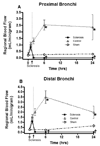
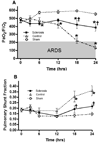

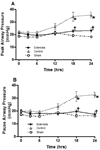
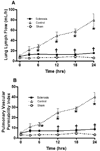
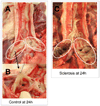

Similar articles
-
Effect of ablated bronchial blood flow on survival rate and pulmonary function after burn and smoke inhalation in sheep.Burns. 2009 Sep;35(6):802-10. doi: 10.1016/j.burns.2008.12.013. Epub 2009 Mar 20. Burns. 2009. PMID: 19303716 Free PMC article.
-
Administration of poly(ADP-ribose) polymerase inhibitor into bronchial artery attenuates pulmonary pathophysiology after smoke inhalation and burn in an ovine model.Burns. 2012 Dec;38(8):1210-5. doi: 10.1016/j.burns.2012.08.021. Epub 2012 Sep 17. Burns. 2012. PMID: 22995423
-
Direct delivery of low-dose 7-nitroindazole into the bronchial artery attenuates pulmonary pathophysiology after smoke inhalation and burn injury in an ovine model.Shock. 2011 Dec;36(6):575-9. doi: 10.1097/SHK.0b013e3182360f2e. Shock. 2011. PMID: 22089125
-
[Pathophysiology of acute lung injury in severe burn and smoke inhalation injury].Anaesthesist. 2009 Aug;58(8):805-12. doi: 10.1007/s00101-009-1560-x. Anaesthesist. 2009. PMID: 19517070 Review. German.
-
The role of the bronchial circulation in the acute lung injury resulting from burn and smoke inhalation.Pulm Pharmacol Ther. 2007;20(2):163-6. doi: 10.1016/j.pupt.2005.12.006. Epub 2006 Jun 22. Pulm Pharmacol Ther. 2007. PMID: 16798035 Review.
Cited by
-
Temperature processing and distribution in larynx thermal inhalation injury with analogy to human airway cells: a mechanism of protection.Am J Transl Res. 2022 Jun 15;14(6):3796-3805. eCollection 2022. Am J Transl Res. 2022. PMID: 35836876 Free PMC article.
-
Could Bronchial Artery Embolization Be a Modality for Treating Severe Acute Respiratory Syndrome Coronavirus 2?J Vasc Interv Radiol. 2020 Dec;31(12):2148-2150. doi: 10.1016/j.jvir.2020.08.022. Epub 2020 Aug 26. J Vasc Interv Radiol. 2020. PMID: 33162308 Free PMC article. No abstract available.
-
Optimal management of the critically ill: anaesthesia, monitoring, data capture, and point-of-care technological practices in ovine models of critical care.Biomed Res Int. 2014;2014:468309. doi: 10.1155/2014/468309. Epub 2014 Mar 25. Biomed Res Int. 2014. PMID: 24783206 Free PMC article. Review.
-
Inhalation injury: epidemiology, pathology, treatment strategies.Scand J Trauma Resusc Emerg Med. 2013 Apr 19;21:31. doi: 10.1186/1757-7241-21-31. Scand J Trauma Resusc Emerg Med. 2013. PMID: 23597126 Free PMC article. Review.
References
-
- Barrow RE, Spies M, Barrow LN, Herndon DN. Influence of demographics and inhalation injury on burn mortality in children. Burns. 2004;30:72–77. - PubMed
-
- Linares HA, Herndon DN, Traber DL. Sequence of morphologic events in experimental smoke inhalation. J Burn Care Rehabil. 1989;10:27–37. - PubMed
-
- Pruitt BA, Jr, Cioffi WG, Shimazu T, Ikeuchi H, Mason AD., Jr Evaluation and management of patients with inhalation injury. The Journal of trauma. 1990;30:S63–S68. - PubMed
-
- Abdi S, Herndon D, McGuire J, Traber L, Traber DL. Time course of alterations in lung lymph and bronchial blood flows after inhalation injury. J Burn Care Rehabil. 1990;11:510–515. - PubMed
-
- Wagner EM, Blosser S, Mitzner W. Bronchial vascular contribution to lung lymph flow. J Appl Physiol. 1998;85:2190–2195. - PubMed
Publication types
MeSH terms
Substances
Grants and funding
LinkOut - more resources
Full Text Sources

